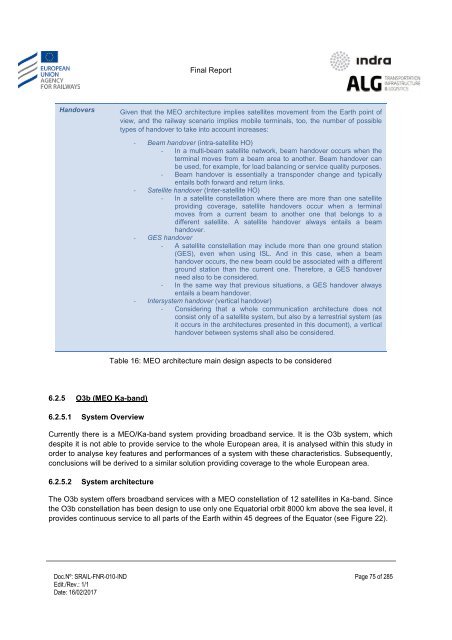Study on feasibility of SATCOM for railway communication
SRAIL-FNR-010-IND%20-%20FinalReport_v1.1_20170216
SRAIL-FNR-010-IND%20-%20FinalReport_v1.1_20170216
Create successful ePaper yourself
Turn your PDF publications into a flip-book with our unique Google optimized e-Paper software.
Final Report<br />
Handovers<br />
Given that the MEO architecture implies satellites movement from the Earth point <strong>of</strong><br />
view, and the <strong>railway</strong> scenario implies mobile terminals, too, the number <strong>of</strong> possible<br />
types <strong>of</strong> handover to take into account increases:<br />
- Beam handover (intra-satellite HO)<br />
- In a multi-beam satellite network, beam handover occurs when the<br />
terminal moves from a beam area to another. Beam handover can<br />
be used, <strong>for</strong> example, <strong>for</strong> load balancing or service quality purposes.<br />
- Beam handover is essentially a transp<strong>on</strong>der change and typically<br />
entails both <strong>for</strong>ward and return links.<br />
- Satellite handover (Inter-satellite HO)<br />
- In a satellite c<strong>on</strong>stellati<strong>on</strong> where there are more than <strong>on</strong>e satellite<br />
providing coverage, satellite handovers occur when a terminal<br />
moves from a current beam to another <strong>on</strong>e that bel<strong>on</strong>gs to a<br />
different satellite. A satellite handover always entails a beam<br />
handover.<br />
- GES handover<br />
- A satellite c<strong>on</strong>stellati<strong>on</strong> may include more than <strong>on</strong>e ground stati<strong>on</strong><br />
(GES), even when using ISL. And in this case, when a beam<br />
handover occurs, the new beam could be associated with a different<br />
ground stati<strong>on</strong> than the current <strong>on</strong>e. There<strong>for</strong>e, a GES handover<br />
need also to be c<strong>on</strong>sidered.<br />
- In the same way that previous situati<strong>on</strong>s, a GES handover always<br />
entails a beam handover.<br />
- Intersystem handover (vertical handover)<br />
- C<strong>on</strong>sidering that a whole communicati<strong>on</strong> architecture does not<br />
c<strong>on</strong>sist <strong>on</strong>ly <strong>of</strong> a satellite system, but also by a terrestrial system (as<br />
it occurs in the architectures presented in this document), a vertical<br />
handover between systems shall also be c<strong>on</strong>sidered.<br />
Table 16: MEO architecture main design aspects to be c<strong>on</strong>sidered<br />
6.2.5 O3b (MEO Ka-band)<br />
6.2.5.1 System Overview<br />
Currently there is a MEO/Ka-band system providing broadband service. It is the O3b system, which<br />
despite it is not able to provide service to the whole European area, it is analysed within this study in<br />
order to analyse key features and per<strong>for</strong>mances <strong>of</strong> a system with these characteristics. Subsequently,<br />
c<strong>on</strong>clusi<strong>on</strong>s will be derived to a similar soluti<strong>on</strong> providing coverage to the whole European area.<br />
6.2.5.2 System architecture<br />
The O3b system <strong>of</strong>fers broadband services with a MEO c<strong>on</strong>stellati<strong>on</strong> <strong>of</strong> 12 satellites in Ka-band. Since<br />
the O3b c<strong>on</strong>stellati<strong>on</strong> has been design to use <strong>on</strong>ly <strong>on</strong>e Equatorial orbit 8000 km above the sea level, it<br />
provides c<strong>on</strong>tinuous service to all parts <strong>of</strong> the Earth within 45 degrees <strong>of</strong> the Equator (see Figure 22).<br />
Doc.Nº: SRAIL-FNR-010-IND<br />
Edit./Rev.: 1/1<br />
Date: 16/02/2017<br />
Page 75 <strong>of</strong> 285


